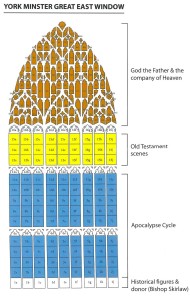The idea of incentivizing a contractor to achieve the objectives specified in a contract are far from new. One example of this is the glazing of the Great East Window of York Minster in the early 15th century.
The cathedral was built between 1220 and 1472 on the site of an older Saxon cathedral. Its Great East Window was glazed between 1405 and 1408. The window is the largest medieval stained-glass window in UK at a bit over 9m wide x 23m tall (larger than tennis court), containing over 300 glazed panels. It was one of the most ambitious windows ever to have been made in the Middle Ages. The design contains two biblical cycles, Creation and Revelation, the beginning and the end of all things. Beneath the heavenly realm at the head of the window, populated by angels, prophets, patriarchs, apostles, saints, and martyrs, there are three rows of 27 Old Testament scenes from the Creation to the death of Absalom. Below this, scenes from the Apocalypse appears, with a row of historical figures at the base of the window. The complex narratives that the window explores represented a true collaboration of teams of clergy and craftsmen, combining advanced liturgical knowledge with the glass-painters’ genius.
Walter Skirlaw, bishop of Durham between 1330 and 1406, has been recognized as the donor of the Great East Window. Its creation was the work of celebrated Coventry glazier John Thornton. Little is known of Thornton’s career, but he was presumably a master glazier of some renown when he was awarded this major work at York Minster. Skirlaw had served as bishop of Coventry so it is likely he was at least in part responsible for bringing Thornton to York.
Neither the size or location of Thornton’s York workshop is known, but the glazing contract formed between him and the Chapter at York reveals that he alone was responsible for the design of the window and much of the key painted details. Analysis of the painting styles shows that there were several glass-painters at work on the window. Nonetheless, the window is characterized by the consistently high standard of painting exhibited across the whole window, demonstrating that Thornton selected his collaborators with great discernment and applied strict quality control.
The contract between Thornton and the Church to glaze the window, has a base price of £46 plus an incentive fee of £10 payable if the work was finished within 3 years. The project was completed within the allowed time and Thornton received his full payment of £56 which is the equivalent of £375,000.00 in today’s money (US$450,000+).
The records held by York Minster show several ‘modern’ aspects of this contract:
- The project was the equivalent of a ‘design and construct’ contract
- Incentive fee payments were in use in the 15th century
- Quality was both important and controlled.
We don’t know how much interaction there was between the clergy and the glaziers, but it is likely for such an important commission, there were regular reviews of both the detail design before work on a panel started, and the completed panel before installation.
On a closing note, Thornton’s fee contrasts significantly with the £11 million recently paid to the York Glaziers Trust to restore and clean the window.
For more on the history of construction management see: The evolution of construction management – Building Projects



